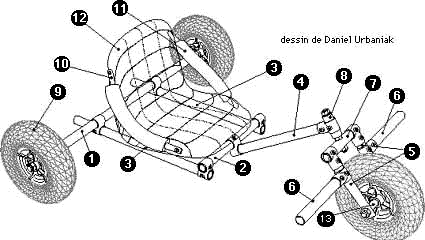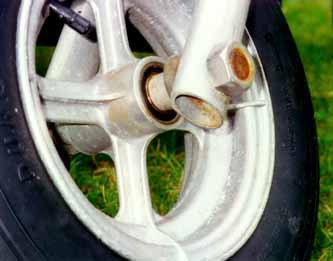

Read the instructions with care. Three (3) times minimum.
Build the buggy in your dreams.
This is just a translation. I'm sure there must be mistakes in it.

The cutting of tubes:Cut the parts made from the tube of AU4G 35 x 31. The parts which form or are part of: the frame (n°1, 3), the downtube (n°4), the front fork (n°5, 6, 7). See the composition drawing. Cut the parts made from the tube AU4G 35 x 25. One length of 420 mm (central frame tube n°2) and one length of 85 mm (head downtube, n°8). Cut 8-10 spacers, used as reinforcements, each 30 mm long, from the tube dural 30 x 26 mm.
For the assembly of the rear-axle you have to use tube n°1 in which you force on each end the hexagonal spacer n°a. Remove on one side of the hexagonal spacers n°a the sharp edges. The force required deformes the tube. It gets a little hexagonal shaped. Use a rubber hamer or an iron one with a piece of wood in between to prevent deforming n°a. NOTE: "You have only one change. Do it right and force it with care because you migth split the tube n°1 if you do it to wild". Remove sharp edges. At the end the hexagonal spacer n°a is jammed for life in tube n°1. Cut 2 pieces of the thread rod (Ø 20 mm), each of 180 mm length, n°b. Carefull, don't damage the thread !! Mount them in n°a, use some Lock-Tite if you have it, and fix n°b with a contra nut n°c. Use enough force (and use Lock-Tite). Now slip the 2 slip-on fittings Kee Klamp® 45-6 on the rear-axle. The rear axle is finished when you put both wheels on and secure them with the nut with nylop stop n°d. But you are wiser and only put the nut on, to protect the thread, and leave the wheel until the complete buggy is finished. The chassis or frame:
Slip a slip-on fitting Kee Klamp® 45-6 on to the centre of central frame tube (tube n°2, the one which is 5 mm thick) and 1 fitting 45-6 on each end of the tube. Now slip the side frame tubes, n°3, in the end fittings of tube n°2 and the rear-axle. Secure the fittings not to strong. Don't put reinforcements in the tubes at these fittings. They are of no use here. Besides that you want to be able to set the rear-axle more to the back, when needed, which will be difficult with a deformed tube. Cut a piece of tube, to be used as reinforcement, about 20 cm length of AU4G 30 x 26 mm and put it in the downtube n°4 just before you put it in the centre fitting of tube n°2. The reinforcement tube prevents the downtube from being deformed and allows you to adjust the length of the downtube, in the future, to the length of the driver. Secure the fitting loosely, until final settings. |
|
 |
|
Drill one (1) hole at one (1) end of each front fork leg (tube n°5) with diameter of 20 mm (to attach
the front wheel, later). Slip a slip-on fittings Kee Klamp® 10-6 on the other end of the legs (tubes
n°5) and also put a reinforcement ring in the tubes. |
 |
|
|
 |
|
The head of the downtube consists of tube n°8 (AU4G 35 x 25) with a length of 85 mm, in which the round
shaped hexagonal n°e (Ø16 mm x 50 mm) can turn around. The diameter of the round filed (a lot of
work) hexagonal n°e is just below 25 mm. Thus it fits in tube n°8. It can turn freely without to much
margin between them.
Slip the last slip-on fitting 10-6, n°d, over the head of the downtube, tube n°8. Secure it with
FORCE. Now slip this over downtube n°4. Don't forget to use a reinforcement ring. And to secure it ! |
 |
Strip the seat from is legs and |
|
C ut 2 PVC tubes of 600 mm length. Heat the ends and squize them together. Be carefull and don't burn the
PVC. The PVC tubes are the arm rests or side support. Put the foam tube over it. The foam tube may be protected
by a fabric tube made from dacron or spinakker. Position the seat on the 3 tubes of the frame (n°2 and °3 and 3). Then fix the seat in the front to
tube n°2 with a stainless steel bolt/nut Ø 8 mm and in the back to tube n°3 with seatbelt
webbing and a buckle, see drawing.
|
